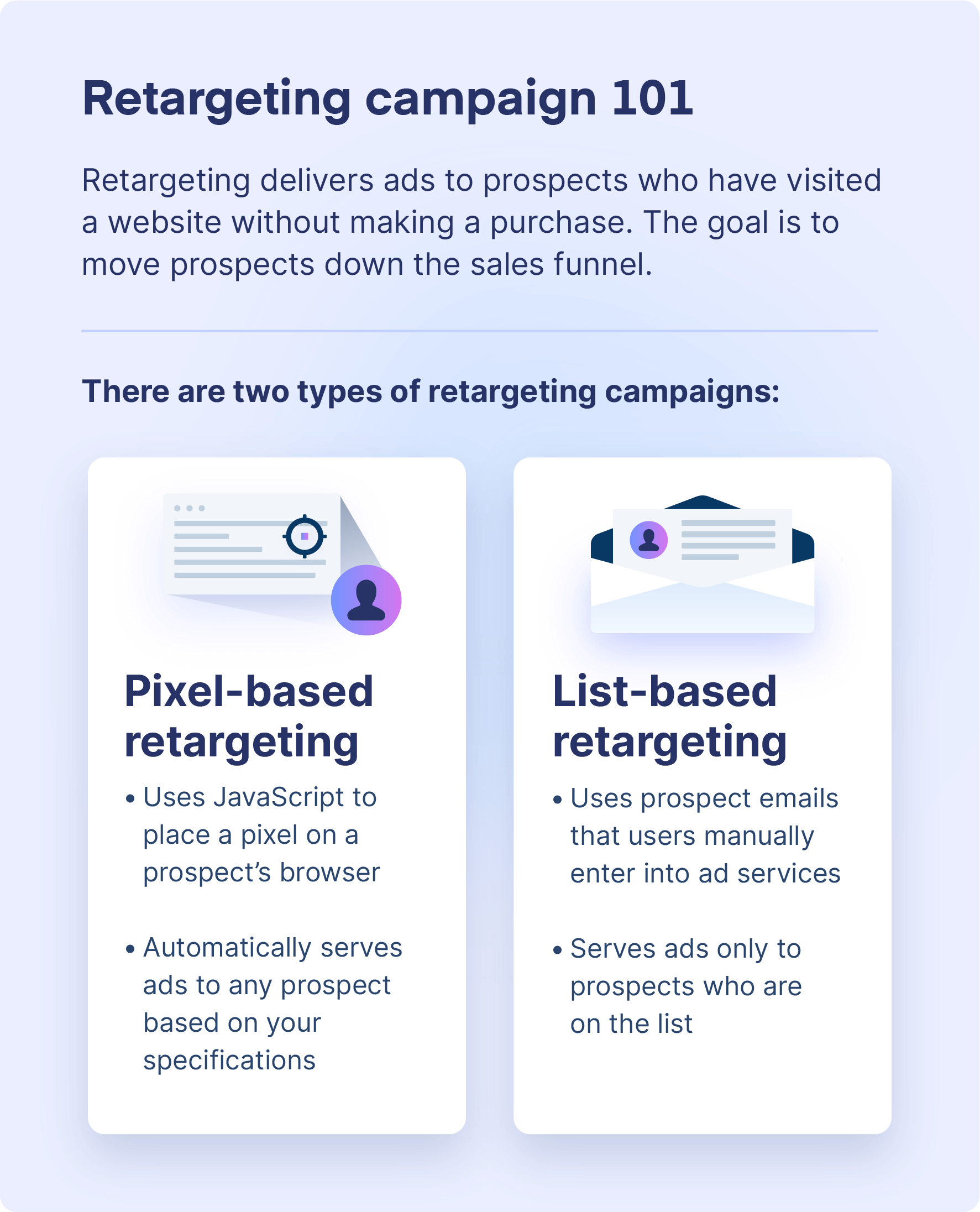B2B retargeting campaigns: 5 ways to improve them and best practices
Only four percent of your website visitors are ready to buy—do you know how to capture the other ninety-six percent?
There are a few different methods to circle back around on the prospects who leave your site without converting, but one of the best ways is with retargeting campaigns.
Retargeting campaigns are a way for businesses to resonate with warm leads who have yet to become customers—but only if the proper steps are taken. In this article, we will cover the basics of retargeting campaigns: what they are, five steps to improve them, and how Clearbit can optimize your retargeting outreach.
What are retargeting campaigns?
Retargeting campaigns are a method of online advertising that delivers ads to prospects who have previously interacted with a business’s website or brand.
The goal of retargeting is to move prospects down the sales funnel, and marketers across industries utilize this method because it works—in fact, prospects who have been retargeted are seventy percent more likely to purchase your offering over the competition.
To explain how this successful marketing method works, let’s run through a hypothetical example.
Jane is an executive at a mid-market level business that is looking for a new lead generation software. She searches Google and finds LeadSnail, a company specializing in exactly what she’s looking for. After browsing the website for a few minutes, Jane leaves without making a purchase but has a technological cookie placed on her browser (more on that later). LeadSnail can use Jane’s cookie to deliver ads across Google, Facebook, and more that are meant for prospects just like her. After browsing through a few different lead generation software options throughout the week, Jane keeps seeing ads for LeadSnail, and decides to purchase from them.
Overall, a company can use retargeting campaigns just like this to identify website visitors and deliver personalized content across the internet.
How does retargeting work?
Retargeting campaigns can work in two different ways: pixel-based retargeting or list-based retargeting.
Pixel-based retargeting
Pixel-based retargeting uses pixels, or cookies, to retarget prospects.
This is the most common form of retargeting, in which JavaScript virtually attaches a pixel to a prospect’s browser once they have visited your website. After the prospect leaves, the pixel notifies online advertisers such as Google and Facebook to serve them relevant ads based on their browsing history—things like what pages they visited and products they viewed on your site.
Pixel-based retargeting is advantageous because relevant, personalized advertising can be served as soon as the prospect leaves a website without making a purchase.
List-based retargeting
List-based retargeting involves targeting the prospects your business already has information on.
Maybe your business put out a successful lead magnet, or you have a large email list filled with prospects who have not yet become paying customers. With list-based retargeting, you can upload their email addresses to a retargeting platform—again, likely Google or Facebook ads—and the prospect will receive tailored messaging based on your specifications.
This method is not as popular as pixel-based retargeting because of the time it takes to gather and upload email addresses manually, but it does afford the ability to target prospects with hyper-focused messaging, which can be extremely effective.

Retargeting vs. remarketing campaigns
Retargeting and remarketing are often used interchangeably, but there is a slight difference between the two.
Both of these methods involve serving advertisements to prospects who have previously interacted with your business, and both can be implemented for individuals in different stages of the customer journey. The difference is that retargeting campaigns typically reach out to prospects through the use of cookies, or a pixel-based method, whereas remarketing typically uses email.
When to use retargeting campaigns
Retargeting campaigns are an effective way to reach prospects, and they can be used to meet a few different goals:
- Build awareness: Retargeting campaigns result in prospects interacting with your messaging more frequently. Advertising impressions and engagement dramatically increase with this method, even if sales don’t catch up right away.
- Generate conversions: Serving advertisements to prospects who have previously visited your website often results in higher click-through rates. This means you can personalize your landing pages to speak to prospects in the most effective way possible.
- Optimize your sales funnel: The overarching goal of retargeting is to move prospects down your sales funnel. This method can help your business turn website visitors, those who have submitted contact information, and other warm leads into paying customers.
- Reduce abandonment: Retargeting entices prospects to return to your website. This means you can mitigate cart abandonment and other lost sales with the correct messaging.

5 ways to improve your retargeting campaigns
Running retargeting campaigns is easy—but mastering them to achieve an optimal ROI can be difficult. Moving forward, we will touch on five ways you can improve your campaigns.
1. Use tools focused on targeting and personalization
Retargeting campaigns are most effective when paired with tools that focus on targeting and personalization.
With proper ad targeting, you can reach large, highly qualified audiences using hundreds of filters such as industry, company size, and job position. Tools like Clearbit, allow you to define audiences in order to serve the ideal prospect's optimal ad messaging across Google, Facebook, YouTube, and more. By focusing on your best-fit prospects, you can reduce wasted ad spend across your campaigns.
But it’s not enough to target the right audience—the content needs to resonate with them as well. With personalized content, your ads and landing pages emerge from the background noise to truly stand out to your prospects. Tools like Mutiny make it easy to create personalized landing pages that speak to individuals at their respective stages in the buyer journey and will go a long way in improving retargeting campaigns and, ultimately, conversion rates.
When you find the right tools that allow you to perform these functions with ease, your retargeting effectiveness will exponentially increase.
2. Focus on your ideal customer profile (ICP)
An ideal customer profile (ICP) is a description of a company that’s a perfect fit for your product or service. In other words, it’s a snapshot of what your ideal customer would look like—and therefore, realize the most value—for your offering. Focusing on perfect-fit customers results in a more efficient ad spend because you’re performing outreach to those that are more likely to convert.
Effective ICPs include firmographic and technographic data that describe the core attributes of this ideal company—things like industry, location, company size, and more. All of this information combines to form a profile from which your business can optimize retargeting campaigns and other forms of outreach.
As we touched on above, retargeting success greatly hinges on how relevant your messaging is. When you focus on your ICP in your ad campaigns, you will produce content that speaks directly to them—improving your conversion rates and ROI.
Additionally, a clearly defined ICP not only helps with retargeting, but it can improve your efficiency across the board, ensure alignment across your teams, and help to prioritize revenue and customer lifetime value.
3. Optimize ad frequency
One major pitfall for unsuccessful retargeting campaigns is getting the timing wrong.
Retargeting affords the ability to serve ads to prospects as soon as they leave your website, however frequently you choose. But there must be a healthy balance, and many businesses miss the mark.
Serving prospects too many ads in a short time period can make them feel as though they are being virtually stalked, with your advertisements lurking around every technological corner. In fact, according to a GWI report, just over half of all consumers get irritated when they see too many ads from the same brand.
On the other hand, not serving enough ads can prove to be ineffective, and prospects may turn to other businesses instead.
It’s up to you and your team to find the happy medium, but a good rule of thumb is to allocate 20% of your marketing budget toward retargeting. This budget spread equally across all of your targeted prospects should be a good starting point for ad frequency.
From there, you should evaluate performance—and conduct customer surveys if appropriate—to find the perfect frequency for your industry.
4. Improve your creative
In an age where a large number of consumers are using ad blockers, you need to make sure your content is unique enough to capitalize on the prospects who will be seeing your ads.
As we touched on above, ad creative should start and end with your ICP. Once you have that firmly in mind, your copy should follow a few best practices:
- Have the right offer: Retargeting ads can be deployed to prospects in different stages of the sales funnel. Some ads may be focused on building brand awareness, while others could be focused on getting a prospect to return to your site and finish a purchase. Make sure your ad copy reflects the type of prospect you are targeting.
- Be respectful of consumer information: When creating copy for retargeting campaigns, there’s a fine line between creepy and effective. In today’s marketplace, many consumers notice when they are being targeted by ads, but they can be particular about the way their information is shared. If consumers think you got their data from untrustworthy sources, their purchase interest drops considerably. Make sure you create ads that don’t feel too intrusive.
- Align your messaging: Make sure your ads align with the copy on your website and other branding initiatives. Even though you may have multiple variations to account for prospects in different stages of the sales funnel, the copy should still sound like it is coming from the same source.
5. Retarget identified visitors
When running retargeting campaigns, you will likely find the most success by engaging with identified website visitors. In fact, we’ve found that site visitors who have been identified with our Reveal capabilities are of significantly higher value for B2B companies than unidentified traffic.
Andrew Breen, president of Outshine, agrees—when serving prospects bottom-of-the-funnel advertisements, they saw a 215% higher conversion rate with identified visitors than with unidentified traffic.
Retargeting campaign FAQ
Finally, we will wrap up with a few commonly asked questions about retargeting campaigns.
What are the types of retargeting campaigns?
There are two types of retargeting campaigns: pixel-based retargeting, which uses cookies to track and serve ads to website visitors, and list-based retargeting, which uses a contact list to manually reach prospects.
What are some retargeting strategies?
There are a variety of retargeting strategies to ensure campaign success, including using tools focused on targeting and personalization, focusing on your ICP, optimizing ad frequency, improving your creative, and retargeting identified visitors.
What is the best campaign for retargeting?
There isn’t necessarily a “best” campaign strategy to use with retargeting. Every business has different goals and prospects, but if you align your messaging with your ICP and follow our tips above, you should see success in your advertising efforts.
Clearbit can aid in retargeting success
Retargeting campaigns can be lucrative for a business, but they can also fall flat if you don’t take the proper steps and strategies. A few different ways to ensure success is by focusing on your ICP, optimizing ad frequency, and improving your creative. That being said, one of the best methods to ensure retargeting success is with the help of tools.
At Clearbit, our data powers ad targeting and advanced personalization capabilities to enhance and optimize the effectiveness of your retargeting campaigns.

